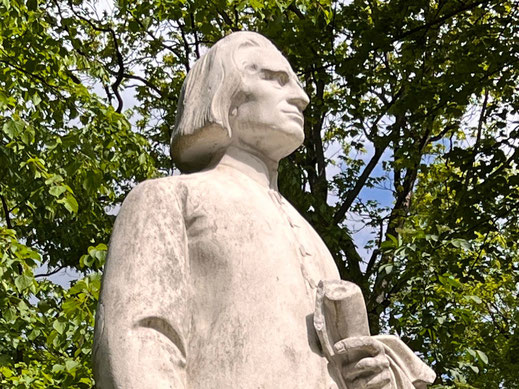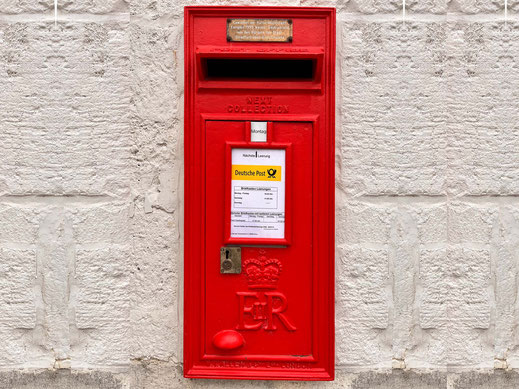Dr. phil. Wolfgang Fuchs
Certified City Guide of Weimar
Tour 1
1.5 hours or 2 hours
Highlights of Weimar
in City Centre and Goethe Park
12 UNESCO World Heritage Sites, seven wonderful parks and more than 30 museums are located in Weimar. Please join me on tours through city and park tailored according to your interests and wishes. Discover historical places, their stories, backgrounds and anecdotes. Learn fascinating facts about the city which, once situated beyond the great trade routes, sought its profile more in art, literature and park design than in industry and commerce. Get to know the city in which German history – from the Classical period to the Weimar Republic and Bauhaus to national socialist barbarism – is reflected as if in a burning glass.


Tour 2
1.5 hours or 2 hours
Weimar's Fab Four
Goethe, Schiller, Wieland, and Herder
Discover where Weimar's (not Liverpool’s!) "Fab Four" lived, worked and loved. Learn authentic anecdotes that will make you marvel and smile. Discover the importance not only of Johann Wolfgang von Goethe and Friedrich Schiller, but also of Christoph Martin Wieland as initiator of German Classicism and prince educator to the duke, as well as the humanist cultural and linguistic philosopher, vicar of the city church and superintendent Johann Gottfried Herder with his motto "Light, Love, Life".


Tour 3
1.5 hours or 2 hours
Goethe in Weimar
Where Goethe lived, worked, and loved.
This tour is dedicated to the poet, researcher and minister Goethe and his social environment: How did he come to Weimar and what were his duties here? How did he achieve his success at court, in literature and in many fields of science and art? Why did he travel - or flee - to Italy? How and where did he coin Weimar? Who were his friends and who were the women in his life? Where did he fail? What can we learn from Goethe today?


Tour 4
2 or 3 hours
Weimar, the City in the Park
From city centre to Goethe Park
"Weimar is actually a park in which a city lies," wrote novelist Adolph Stahr. The Ilmpark, also called Goethe Park, right next to the historic centre, brings the history and stories of Weimar and its celebrities to life. Only a few steps away from each other lie cultural treasures that we visit together: Duchess Anna Amalia Library, Goethe's Garden House, Residence Castle, Schiller Bench, Liszt Monument, Roman House, Dessau Stone, Serpent Stone, Germany's oldest preserved suspension bridge - and, if you have a little more time, the Model House at the Horn, an impressive attraction of the Bauhaus exhibition in 1923.


Tour 5
approx. 2 hours
The Bauhaus
Originated in Weimar
Universal artist Henry van de Velde had prepared the ground when Walter Gropius united Grand-Ducal Art Academy and School of Arts and Crafts in Weimar forming the Bauhaus in 1919. His students were called apprentices and journeymen, his professors were called masters. As such, he appointed Lyonel Feininger, Johannes Itten, Georg Muche, Paul Klee, Oskar Schlemmer and many others. They dared to experiment: the unification of architecture, fine arts and crafts. Learn about the history of the Bauhaus at the historic sites - on the Bauhaus University campus, the Model House at the Horn, in park and city. Discover what Bauhaus refectory had to do with London's Crystal Palace of 1851 and a professor who painted animals.


Tour 6
approx. 2 hours
Great Composers
Bach, Hummel, Liszt, Wagner, Strauss in Weimar
The list of musicians and composers who worked in Weimar is long: Johann Sebastian Bach, who was musically shaped here, Franz Liszt, who gave his name to the Weimar University of Music, Mozart's disciple Johann Nepomuk Hummel, Richard Wagner, who was wanted by the police at the time, Richard Strauss, Hans von Buelow, Peter Cornelius, Hector Berlioz, Friedrich Smetana, Joseph Joachim - to name but a few. Wagner's “Lohengrin”, Richard Strauss's “Don Juan” and “Macbeth” as well as Engelbert Humperdinck's “Hansel & Gretel” were premiered here.


Tour 7
approx. 2 hours
Enchanting places in the charming park of Tiefurt
wonderful atmosphere and mesmerizing corners
21 hectares in size, the landscape park designed in the English garden style with the idyllic country estate, which was granted to Constantin, the younger brother of Duke Carl August. Anna Amalia, the Duke's mother, lived her country life here with breakfast in the meadow. She turned the park into a theatre set where Goethe's singspiels and ballads were performed. Join me as we walk through English garden art on fairytale-idyllic paths and bridges to muse temples, park design jewels and places of memory and surprise such as the Mozart monument.


Tour 8
approx. 1.5 hours
Great Britain and Weimar
Discover the many points of connection
Hard to believe: Weimar's Ilmpark is home to the only Shakespeare monument on the continent, erected to mark the founding of Germany's Shakespeare Society which still celebrates its annual meetings in Weimar. Next to the town hall which chimes the Westminster Quarters of London‘s Big Ben on the hour is a British post-box donated by Stratford-upon-Avon in 1999 when Weimar became European Capital of Culture. The city's parks are designed in the English garden style. The very likely first biographer of Goethe was the Englishman George Henry Lewes, who visited Weimar in 1854 together with the author George Eliot. His 600-page biography of Goethe "Life of Goethe" was published in 1855 and translated into German by Julius Frese two years later. For Ottilie von Goethe, the daughter-in-law of the poet prince Goethe, who revered and translated Lord Byron, English was the "language of the heart". The Duke of Weimar, who counted the Britons Charles Gore and his daughters among his court, became a member of the Royal Horticultural Society London in 1817 and sent his court gardener to Britain to study British horticulture. Mary Shelly was inspired by Goethe and adored Schiller. Britain and Weimar have many points of contact, right up to Weimar's leading contemporary garden architect – a Briton. Would you like to know the whole story? Would you like to know which building in Weimar was modelled after the Crystal Palace in London?


Photos and videos are also shown on all tours.
Dr. phil. Wolfgang Fuchs
+49 152 2848 3671
wolfgang.fuchs[at]live.de